Introducing Taiwan’s Tourist Attractions by Station: From Major Spots to Hidden Gems Not Found in Guidebooks
Recommended Tourist Spots Around Tamsui Station
- Tamsui Old Street 淡水老街
- Tamshui Gold Seashore 淡水金色水岸
- Tamsui Night Market 淡水夜市
- Bali Ferry Street 八里渡船頭街
- Hezhong Temple 淡水和衷宮
- 3D Image Painted Stairs 3D意象彩繪階梯
- Tamsui Japanese Police Dormitory 淡水日本警官宿舎
- Tada Residence 多田邸
- Tamsui Fuyou Temple 淡水福佑宮
- Santo Domingo Castle 紅毛城
- Drop of Water Memorial Hall 一滴水紀念館
- Tamsui Fisherman’s Wharf 淡水漁人碼頭
- Hongshulin Ecological Pathway 紅樹林生態歩道
- There weren’t any touristy spots
- Guandu Temple 關渡宮
- Guandu Nature Park 關渡自然公園
- Guandu Bridge 關渡大橋
- Guandu Riverside Park 關渡河濱公園
- Xingtian Temple Beitou Branch
- Kuandu Museum of Fine Arts 關渡美術館
- There weren’t any touristy spots
- Xinbeitou Historic Station 新北投車站
- Beitou Park 北投公園
- 北投図書館
- Plum Garden梅庭
- Beitou Hot Spring Museum北投温泉博物館
- Beitou Hot Spring 北投温泉
- Geothermal Valley 地熱谷
- The Beitou Museum 北投文物館
- Fagushan Nongchan Temple 法鼓山農禅寺
- Warship Rock 軍艦岩
- Shipai Night Market 石牌夜市
- Yangmingshan National Park 陽明山国家公園
- There weren’t any touristy spots
- Zhishanyan Cultural and Historical Park 芝山岩文化史蹟公園
- Zhishanyan Huiji Temple 芝山巖惠濟宮
- Tianmu 天母
- San Yu Gong 三玉宮
- The National Palace Museum 国立故宮博物院
- Shilin Residence 士林官邸
- Taipei Astronomical Museum 台北市立天文科学教育館
- National Taiwan Science Education Center 國立臺灣科學教育館
- Shilin Night Market 士林夜市
- Shilin Cixian Temple 士林慈誠宮
- Grand Hotel 圓山大飯店
- Jiantan Mountain 剣潭山観景台
- National Revolutionary Martyrs’ Shrine 忠烈祠
- Huabo Park 花博公園
- Linji Huguo Chan Temple 臨濟護國禪寺
- Mt. Lungtung 龍峒山
- Yuanshan Nature Landscape Park 圓山自然景觀公園
- Taipei Fine Arts Museum台北市立美術館
- Dalong Street Night Market 大龍街夜市
- Taipei Confucius Temple 孔子廟
- Dalongdong Baoan Temple 大龍峒保安宮
- Juexiu Temple 台北覚修宮
- Shuangcheng Street Night Market 雙城街夜市
- Wenchang Temple 文昌宮
- Xinzhongshan Linear Park 心中山線形公園
- Zhongshan Station 中山駅付近
- Linsen Park 林森公園
- Linsen North Road 林森北路
- Taipei Museum of Contemporary Art 台北當代藝術館
- Taipei Main Station
- Yixian Park 逸仙公園
- 228 Peace Memorial Park 二二八和平公園
- National Taiwan Museum 国立台湾博物館
- Taipei Guest House 台北賓館
- Taipei Prefecture City East Gate (Jingfu Gate) 臺北府城 東門(景福門)
- National Chiang Kai-Shek Memorial Hall 国立中正紀念堂
- National Taiwan Museum Nanmen Branch 国立台湾博物館 南門館
- 228 National Memorial Hall 二二八国家記念館
- National Museum of History 国立歴史博物館
- Taipei Botanical Garden 台北植物園
- Nanjichang Night Market 南機場夜市
- Yongkang Street 永康街
- Dongmen Market 東門市場
- Daan Park 大安森林公園
- There weren’t any touristy spots
- Tonghua Street Night Market 通化街夜市
- Taipei 101 台北101
- The Taipei 101 Countdown Fireworks
- Si Si Nan Cun 四四南村
- Xiangshan hiking trail 象山ハイキングコース
- Daitian Temple Lingyun Palace 代天殿霊雲宮
Tamsui Old Street 淡水老街

Tamsui Old Street is a place where you can feel the history of Tamsui, which once flourished as a trading port. The nostalgic streets are lined with old buildings and traditional shops. Here, you can enjoy local delicacies and shop for souvenirs. Especially on weekends, it is bustling with many tourists and full of energy.
Tamshui Gold Seashore 淡水金色水岸

Tamshui Gold Seashore is a riverside promenade perfect for cycling and walking. You can refresh yourself in nature while enjoying the beautiful scenery of the Tamsui River. Especially in spring and autumn, you can spend a relaxing time in the pleasant weather.
Tamsui Night Market 淡水夜市
Tamsui Night Market is a night market where you can enjoy local street food and shop for souvenirs. It becomes bustling with people at night, creating a lively atmosphere. You can experience Taiwan’s night market culture while interacting with the locals.
Bali Ferry Street 八里渡船頭街
Bali Ferry Street once flourished as an important ferry terminal connecting Tamsui and Bali. Ferries frequently crossed the Tamsui River, facilitating vibrant commercial activities. This area also played a crucial role as a trading hub between Taiwan and mainland China. Bali Ferry Street is beautifully preserved, allowing visitors to feel the history just by walking through it. The street is lined with many small shops and stalls where you can enjoy local specialties and delicious food.
Access: It is accessible by ferry from Tamsui, taking about 10 minutes.
Hezhong Temple 淡水和衷宮

Located on Gongming Street in Tamsui District, this historic Taoist temple was founded in 1857 (the 7th year of the Xianfeng era of the Qing Dynasty) and enshrines Zhu Fu San Wang Ye as the main deity. This temple, also known as “San Ye Guan,” serves as a central place of worship for the local community.
Hezhong Temple underwent major renovations in 1976 and 2012, resulting in the current two-story structure. Inside the temple, you can find other deities such as the Three Pure Ones, Guanyin Bodhisattva, and the God of Wealth. Hezhong Temple is deeply revered by local fishermen and residents for the legend that Zhu Fu San Wang Ye can ward off evil spirits and epidemics. Additionally, the area around the temple is popular with tourists, featuring stalls selling fried squid and other local delicacies.
3D Image Painted Stairs 3D意象彩繪階梯

The 3D Image Painted Stairs are colorful, painted steps that make for a great photo spot. As a unique piece of art, it attracts many tourists. Climbing the stairs offers a breathtaking panoramic view of Tamsui’s cityscape.
Tamsui Japanese Police Dormitory 淡水日本警官宿舎

Tamsui Japanese Police Dormitory was built in 1895 during the Japanese colonial period as accommodation for police officers. It was later used for many years as the residence of the Tamsui County Police Chief and the Director of the Tamsui Branch of the New Taipei City Police Department. After the residents moved out in 2007, it was preserved as a historical building, underwent renovation in 2018, and was opened to the public in December 2019.
Architectural Features
- Eclectic Style: Combines traditional Japanese tatami rooms and verandas with Western-style reception rooms.
- Wooden Structure: A wooden building with a tiled roof, featuring tatami rooms and Western-style reception areas inside.
- Air Raid Shelter: There is an air raid shelter outside the building, offering a glimpse into pre-war times.
Highlights
- Entrance and Reception Room: A Western-style reception room with a desk and sofas is located right next to the entrance.
- Veranda: From the veranda, you can enjoy views of the Tamsui River and Guanyin Mountain, especially beautiful at sunset.
- Exhibits: Displays of tiles and vases used during that period.
Access and Information
Closed: Tuesdays
Opening Hours: Weekdays 09:30 – 17:00, Weekends 09:30 – 18:00
Tada Residence 多田邸

The Tada Residence is a Japanese-style house built during the Japanese colonial period and is now preserved as a cultural heritage site. The building is wooden and incorporates traditional Japanese architectural styles, allowing visitors to experience the lifestyle and culture of that era.
The Tada Residence was built in the 1920s by the Japanese Tada family, who were engaged in commercial activities in Tamsui. This house was used as their residence. After the war, when Taiwan was returned, the building was preserved and is now open to the public as a tourist attraction.
The Tada Residence features traditional Japanese wooden architecture, with a tiled roof, shoji (paper sliding doors), and tatami rooms. The garden is beautifully maintained, offering seasonal landscapes to enjoy. Inside the residence, you can see household items and furniture from that time, providing a glimpse into the lifestyle during the Japanese colonial period. The Japanese-style garden, with its pond and stone lanterns, offers a quiet and serene atmosphere, perfect for a leisurely stroll.
Tamsui Fuyou Temple 淡水福佑宮

Tamsui Fuyou Temple is a historic Taoist temple located on Zhongzheng Road in Tamsui District, dedicated to the goddess Mazu as its main deity. It was founded in 1782 (the 47th year of the Qianlong era of the Qing Dynasty) and is one of the oldest temples in Tamsui.
Fuyou Temple was rebuilt in 1796 (the 1st year of the Jiaqing era) and was designated as a third-class historic site by the Ministry of the Interior in 1980. Inside the temple, there is a plaque inscribed with “Yuetian Zhaoyou,” which was bestowed by Emperor Guangxu to commemorate Mazu’s divine intervention during the Sino-French War.
Santo Domingo Castle 紅毛城
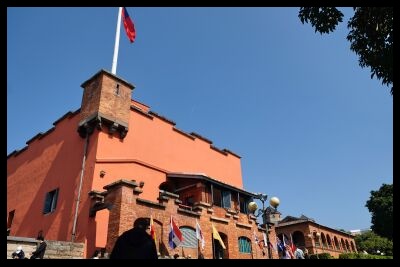
Fort San Domingo, also known as “Santo Domingo Castle,” is a historic fortress located in Tamsui District, New Taipei City, Taiwan. Here are the details about Fort San Domingo:
Fort San Domingo was originally built by the Spanish in 1628 but was rebuilt by the Dutch in 1644. It was later used as the British Consulate from 1867 to 1980. Fort San Domingo is one of the oldest existing buildings in Taiwan and has been designated as a national first-class historic site.
Fort San Domingo is characterized by its sturdy structure with outer walls 1.9 meters thick. The site features old cannons, which were brought by the British for decoration. Additionally, the consulate area includes a typical two-story British colonial-style building.
Highlights
Anthony Fortress: Built by the Dutch, it forms the main part of the current Fort San Domingo.
Former Qing Dynasty British Consulate Residence: A brick Western-style building that can be visited as part of the Fort San Domingo complex.
Access
Fort San Domingo is about 1.5 kilometers from MRT Tamsui Station and is conveniently accessible by bus or taxi. For buses, you can take routes Red 26 or 836.
Opening Hours: Monday to Friday 09:30 – 17:00, Weekends and Taiwanese holidays 09:30 – 18:00
Closed: The first Monday of each month, Lunar New Year’s Eve, and other holidays
Drop of Water Memorial Hall 一滴水紀念館
The Drop of Water Memorial Hall (Itteki-sui Kinenkan) is a historic building located in Heping Park, Tamsui District, New Taipei City. This memorial hall is a relocated traditional Japanese house that symbolizes the friendship between Japan and Taiwan, born during the Hanshin Earthquake and Taiwan’s 921 Earthquake.
History and Background The Drop of Water Memorial Hall is a wooden structure originally built in 1915 in Oi Town, Fukui Prefecture, Japan. This building was constructed by Mizukami Kakushi, the father of the writer Mizukami Tsutomu, and was relocated to Taiwan between 2005 and 2009.
Architectural Features
Wooden Structure: Over 600 beams and pillars were used, assembled without any nails.
Japanese Garden: Surrounding the building is a beautiful Japanese garden, offering a tranquil atmosphere.
Cultural Exchange: Inside the hall, there are the “Mizukami Tsutomu Library” and the “Chen Shunchen Library,” serving as venues for literary exchange between Taiwan and Japan.
Opening Hours: Tuesday to Sunday 09:00 – 17:00 (09:00 – 18:00 on national holidays) Closed: Every Monday, Lunar New Year’s Eve to the fourth day of the Lunar New Year, election days, and other government-designated holidays.
Tamsui Fisherman’s Wharf 淡水漁人碼頭


Tamsui Fisherman’s Wharf is located at the mouth of the Tamsui River and is famous for its beautiful sunsets. Originally functioning as a fishing port, it is now a popular tourist destination.
Lover’s Bridge: This white arch bridge is illuminated with colorful lights at night, creating a romantic atmosphere that is popular with couples.
Tamsui Fisherman’s Wharf is known as one of the best places in Taiwan to view stunning sunsets, especially from Lover’s Bridge. You can enjoy ferry rides and cruises, with convenient access to Tamsui Old Street and Bali. The area is lined with restaurants offering fresh seafood and stalls selling local specialties.
The wharf is also famous for the “Statue of a Maiden,” a popular photo spot. Created by Taiwanese sculptor Yang Ying-feng in 2004, the statue depicts a girl gazing out at the sea, symbolizing hope and the future.
Recommended Tourist Spots Around Hongshulin Station
Hongshulin Ecological Pathway 紅樹林生態歩道
The Hongshulin Ecological Pathway is a walkway where you can stroll through mangrove forests, making it ideal for nature observation. In the tranquil environment, you can relax while listening to the chirping of birds and the sound of the wind. It is recommended for those who want to spend a leisurely time in nature.
Recommended Tourist Spots Around Zhuwei Station
There weren’t any touristy spots
Recommended Tourist Spots Around Guandu Station
Guandu Temple 關渡宮
Guandu Temple was founded in 1661 (the 18th year of the Shunzhi era of the Qing Dynasty) by the monk Shih Hsing, who came from Fujian Province. Initially, it was called “Tianhou Temple,” but it was later renamed “Guandu Temple.” The temple underwent several renovations during the reigns of the Qianlong, Daoguang, and Guangxu emperors, resulting in its current form.
Architectural Features
Main Hall: The stone walls, pillars, and stone lions inside and outside the main hall are intricately carved with historical stories, creating delicate and spectacular works of art.
Holy Mother Hall, Guanyin Hall, Wenchang Hall: The temple houses multiple halls, each dedicated to different deities.
Ancient Buddha Cave, Guangdu Temple, Drum Tower, Bell Tower: The temple complex includes many other buildings, boasting a vast area.
The Guandu Temple festival is held annually on the 23rd day of the 3rd lunar month, with the Lantern Festival and the Zhongyuan Festival being major events of the year. During these times, many worshippers visit from various places, and the temple is bustling with activity, with incense smoke continuously rising.
Guandu Nature Park 關渡自然公園
It is a recommended spot for nature lovers, where you can enjoy wetlands and bird watching. The scenery changes with the seasons, allowing you to relax and enjoy different views throughout the year. The park is equipped with walking paths and observation decks, making it easy to spend a leisurely time in nature. Especially in spring and autumn, many migratory birds visit, providing excellent opportunities for bird watching.
Guandu Bridge 關渡大橋
Guandu Bridge is a beautiful bridge that spans the Tamsui River, offering particularly stunning views at sunset. From the bridge, you can enjoy a panoramic view of Taipei City. At night, the bridge is illuminated, creating a romantic atmosphere. There are walking paths under the bridge, allowing for pleasant riverside strolls.
Guandu Riverside Park 關渡河濱公園
It is a spacious park, perfect for picnics and walks. Families and friends can spend a relaxing time together. The park has playground equipment and barbecue areas, allowing you to enjoy a full day there. Especially on weekends, it is bustling with many families, giving you a glimpse into the local lifestyle.
Recommended Tourist Spots Around Zhongyi Station
Xingtian Temple Beitou Branch
Xingtian Temple Beitou Branch was established as a branch of Xingtian Temple. Xingtian Temple enshrines Guan Sheng Dijun (Guan Yu), who is widely worshipped throughout Taiwan. Guan Sheng Dijun is revered as a symbol of loyalty and courage.
Kuandu Museum of Fine Arts 關渡美術館Kuandu Museum of Fine Arts is built on a hillside, offering beautiful views overlooking the Guandu Plain. The building itself is designed as part of the art, providing visitors with a unique spatial experience.
Access
Opening Hours: Tuesday to Sunday, 10:00 AM – 5:00 PM (last admission at 4:30 PM)
Closed: Mondays and national holidays
Recommended Tourist Spots Around Fuxinggang Station
There weren’t any touristy spots
Recommended Tourist Spots Around beitou Station and Xinbeitou Station
Xinbeitou Historic Station 新北投車站

Xinbeitou Historic Station was built in 1916 during the Japanese colonial period. At that time, it was known as “Xinbeitou Platform” and was established to provide access to the Beitou Hot Springs. After the Tamsui Line was discontinued in 1988, the station building was dismantled but was rebuilt at its original location in 2017.
Beitou Park 北投公園
It is a spacious park located in the center of the hot spring district. You can enjoy walks and picnics in a lush, green environment, with convenient access to the Hot Spring Museum and Thermal Valley. The park has playground equipment and benches, making it perfect for families and friends to relax. The changing scenery with each season is also a charming feature.
北投図書館


This library is known for its eco-friendly architecture. The beautiful wooden structure and design that incorporates natural light make it an ideal place for quiet reading. The library houses a vast collection of books, including extensive materials on local history and culture. Visitors can relax in a peaceful environment while deepening their knowledge.
Plum Garden梅庭
This historical building was constructed as a villa for Ito Hirobumi, a politician during the Japanese colonial period. Along with its beautiful garden, it offers a glimpse into the lifestyle of that era. Plum trees are planted in the garden, and in spring, they bloom beautifully. The harmony between the historical building and nature is remarkable, providing visitors with a peaceful experience.
Beitou Hot Spring Museum北投温泉博物館
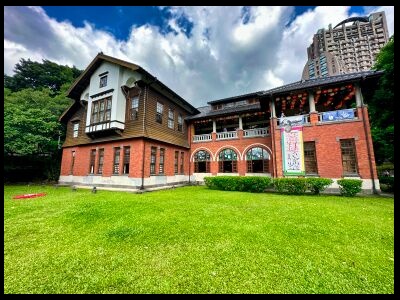
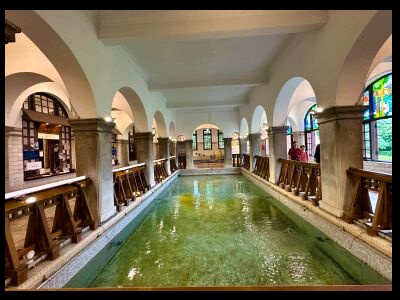
The Beitou Hot Spring Museum began as the largest public hot spring facility in East Asia when it was built in 1913. It was originally known as the “Beitou Public Bathhouse,” but after extensive renovations in 1998, it reopened as the “Beitou Hot Spring Museum.
Beitou Hot Spring 北投温泉
Beitou Hot Springs were discovered by a German in 1894. During the Japanese colonial period, the area was developed into a hot spring resort, and in 1913, a hot spring inn for Japanese visitors was built. This region is considered the birthplace of Taiwan’s hot spring culture, and even today, many hot spring inns and hotels line the area.
Spring Types and Benefits Beitou Hot Springs feature three types of spring water:
White Sulfur Springs: Milky white water, believed to have beautifying effects and benefits for rheumatism and neuralgia.
Blue Sulfur Springs: Light blue-green water, said to help regulate the autonomic nervous system and hormonal balance.
Iron Sulfur Springs: Rich in iron, effective for promoting blood circulation and relieving fatigue.
Geothermal Valley 地熱谷
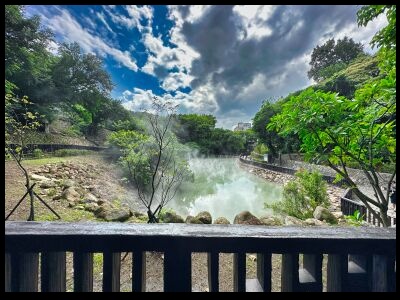
Geothermal Valley is located near Beitou Hot Spring Park and is characterized by its unique landscape, with sulfur smoke rising throughout the year. This place is also known as “Hell Valley” or “Ghost Lake,” and as the names suggest, it exudes an atmosphere reminiscent of hell.
The hot springs in Geothermal Valley are blue sulfur springs (Qinghuang Springs), known for containing trace amounts of radium. These springs are said to be effective for skin diseases, neuralgia, and muscle pain. The temperature of the springs is very high, ranging from 90 to 100 degrees Celsius. In the past, it was possible to make hot spring eggs here, but this is now prohibited for safety reasons.
Steam and Sulfur Smell: When you visit Geothermal Valley, you are greeted by thick steam and a strong sulfur smell. This scene is reminiscent of a dreamlike fairyland.
Hand Bath: Geothermal Valley has a facility called “Hand Bath,” where you can relax by soaking your hands in the hot spring.
New Photo Spots: Recently renovated, Geothermal Valley now features new photo spots. One particularly photogenic spot is where the roots of a banyan tree hang down like a curtain, making it perfect for photography.
The Beitou Museum 北投文物館
The Beitou Museum is a Japanese-style wooden building constructed in the 1920s, originally known as the “Jia Shan Hotel.” During the Japanese colonial period, it was used as a military officers’ club by the Japanese army. After World War II, it became the Jia Shan Guesthouse of the Ministry of Foreign Affairs. In 1998, it was designated as a municipal historic site, and in 2008, it reopened as a museum.
The building is a pure wooden Japanese-style structure, preserving traditional Japanese aesthetics. Highlights include the grand hall, tea room, and bathhouse. The museum exhibits Taiwanese folk artifacts and indigenous art, providing insights into Taiwan’s culture and history. Exhibitions related to Taiwan’s traditional culture and history are held regularly.
Access
Opening Hours: Daily from 10:00 AM to 6:00 PM (Closed on Tuesdays)
Recommended Tourist Spots Around Qiyan Station
Fagushan Nongchan Temple 法鼓山農禅寺

Fagushan Nongchan Temple was established in 1971 by Master Dongchu. He followed the monastic system of Master Baizhang from the Tang Dynasty, advocating a lifestyle of self-sufficiency through agriculture while practicing Zen. The temple was completed in 1975 and is now known as an important origin of Dharma Drum Mountain.
The Main Hall is the center of Nongchan Temple, housing a solemn Buddha statue. Behind the Main Hall is the first two-story farmhouse built, which is now used as the Manjusri Hall.
Shuiyue Dojo is a modern building designed by the renowned architect Yao Renxi, offering beautiful scenery day and night.
Recommended Tourist Spots Around Qilian Station
Warship Rock 軍艦岩
Warship Rock is a popular hiking spot located in Beitou District, Taipei City. It is named “Warship Rock” because its shape resembles a warship. The unique rock formation looks like a floating warship when viewed from a distance.
Warship Rock was formed from alternating layers of sandstone and shale, dating back approximately 24 to 22 million years. Over the long years, it has been shaped by erosion from seawater into its current form.
The Warship Rock Hiking Trail is suitable for beginners to intermediate hikers, offering stunning panoramic views of Taipei City from the summit. On clear days, you can enjoy breathtaking vistas that stretch far into the distance.
Warship Rock can be visited year-round, but spring and autumn are the best seasons for hiking due to the mild climate and the opportunity to fully appreciate the natural beauty.
It is accessible by a 30-minute walk from Qilian Station on the MRT Tamsui Line. Buses are also available from the station.
Recommended Tourist Spots Around Shipai Station
Shipai Night Market 石牌夜市
It has a very local feel. There are hardly any shops aimed at tourists; it’s a place where locals visit daily. It’s perfect for those who want to experience the local atmosphere. You can enjoy various Taiwanese dishes such as potstickers (fried dumplings), wontons, and salty tangyuan (dumpling soup). It’s easily accessible, just a few minutes’ walk from MRT Shipai Station.
Yangmingshan National Park 陽明山国家公園
Yangmingshan National Park is a vast natural park spanning Beitou and Shilin districts in Taipei City, characterized by its rich natural environment and diverse ecosystems. Below are the attractions and highlights of Yangmingshan National Park.
Yangmingshan’s landscape was formed by volcanic activity, creating a unique scenery with hot springs and the smell of sulfur. The park is home to seasonal flowers such as plums, cherry blossoms, peaches, apricots, azaleas, and camellias. Yangmingshan is also ideal for nature observation and bird watching, with many endemic species of birds and plants, including the Taiwan blue magpie.
The Yangmingshan area is rich in geothermal resources, with hot springs scattered throughout. The hot springs in the Beitou area are particularly famous, offering a relaxing experience in sulfur hot springs.
Yangmingshan National Park can be enjoyed for its beauty in all seasons. In spring, cherry blossoms and plums bloom, making it a popular spot for flower viewing. In summer, it is a popular retreat from the heat. In autumn, the silvergrass and autumn leaves are beautiful, and in winter, the hot springs can be enjoyed.
Main Attractions
Xiaoyoukeng: An area where you can see fumaroles from an active volcano and experience geothermal activity up close.
Qingtiangang: A vast grassland area perfect for hiking and picnicking.
Yangming Shuwu: A facility where you can learn about the history and culture of Yangmingshan, enjoying both nature and history.
Lengshuikeng: Known for its hot springs, where you can soak in the hot springs while enjoying nature.
Access
Address: No. 1-20, Zhuzihu Road, Beitou District, Taipei City
Transportation: Accessible by bus from Shipai Station on the MRT Tamsui Line. Since it is quite far from Shipai Station, it is recommended to take a bus to get closer. There are also buses running within the park, making it efficient to visit the main attractions.
Recommended Tourist Spots Around Mingde Station
There weren’t any touristy spots
Recommended Tourist Spots Around Zhishan Station
Zhishanyan Cultural and Historical Park 芝山岩文化史蹟公園
Zhishanyan is a site where the bones of ancestors from about 2,500 years ago were excavated, and it holds many valuable artifacts. Within the park, there are prehistoric cultural relics from the Dabenkeng Culture, Zhishanyan Culture, Yuanshan Culture, and Botanical Garden Culture.
The park is rich in natural beauty, offering wooden walkways for leisurely strolls. It is an ideal spot for nature observation, with a diverse range of plants and birds inhabiting the area.
At the Zhishanyan Exhibition Hall, visitors can learn about the local cultural background and archaeological discoveries. The exhibition hall features displays on the history and culture of the region.
Zhishanyan Huiji Temple 芝山巖惠濟宮
Zhishanyan Huiji Temple is a historic temple located in the Shilin District of Taipei City. It was established in 1752 (the 17th year of the Qianlong Emperor’s reign in the Qing Dynasty) by immigrants from Zhangzhou, Fujian Province, who built it to enshrine their guardian deity, the “Kaizhang Shengwang.” Later, the temple also began to enshrine the Guanyin Buddha, and it became known as “Zhishanyan Temple.”
Zhishanyan Huiji Temple is a fusion of Taoism, Buddhism, and Confucianism, and it enshrines multiple deities. The main hall houses the Kaizhang Shengwang, the rear hall enshrines the Guanyin Buddha, and it also enshrines Wenchang Dijun.
This temple is also considered the birthplace of modern education in Taiwan, and during the Japanese colonial period, a Japanese language school was established here.
In the Wenchang Shrine, which enshrines Wenchang Dijun, there is a “Wenchang Pen.” It is believed that touching this pen brings academic success. The temple grounds feature beautiful stone statues of Buddhist practitioners known as the Sixteen Arhats, the Eighteen Arhats, and the Five Hundred Arhats. The steps on the side of Zhicheng Road Section 2 are lined with lanterns, creating a magical scene at night.
Tianmu 天母
Tianmu is an upscale residential area located in the northern part of Taipei City, known for its large population of foreign residents. Here are some features and attractions of Tianmu:
Tianmu was once called “Sanjiaopu,” but during the Japanese colonial period, a Shinto-based new religion called “Tianmu-kyo” established a shrine (Tianmu Shrine) in the area, leading to its current name. After World War II, many U.S. military personnel and Japanese people moved in, and today, the area still has an international atmosphere with the presence of the American School and Japanese School.
San Yu Gong 三玉宮
San Yu Gong was established in 1947. The main deity worshipped here is Wugu Xian Di, who is revered as the god of agriculture and medicine. This deity is one of the ancient Three Sovereigns and Five Emperors of China and is widely worshipped as the guardian of agriculture and medicine. The temple’s architecture features vividly colored carvings of dragons and phoenixes, creating an oriental atmosphere. Inside the temple, other deities such as Mazu (Heavenly Mother) and Fude Zhengshen (Earth God) are also enshrined.
The exterior of the temple is adorned with intricate carvings and decorations that captivate visitors. The dragon and phoenix carvings are particularly impressive. Inside the temple, there are many statues of deities, and visitors offer prayers to each of them. Centered around Wugu Xian Di, various other gods are also worshipped here.
Recommended Tourist Spots Around Shilin Station
The National Palace Museum 国立故宮博物院
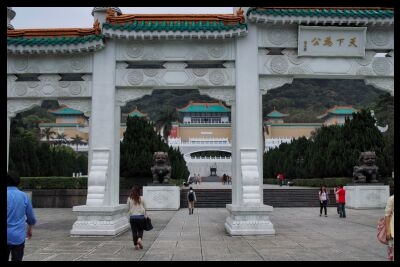
The National Palace Museum is one of the world’s leading museums, located in the Shilin District of Taipei City, Taiwan. It was established in 1925 and moved to its current location in 1965. The museum houses approximately 690,000 artifacts, primarily treasures from the Song, Yuan, Ming, and Qing dynasties, with about 20,000 items on permanent display.
The collection of the National Palace Museum mainly consists of treasures that were originally in the palaces of successive Chinese dynasties. Many of these items were housed in the Forbidden City (now the Beijing Palace Museum) during the Qing Dynasty. The following historical events explain why these treasures were moved to Taiwan:
The Qing Dynasty collapsed in 1911 due to the Xinhai Revolution, leading to the establishment of the Republic of China. In 1925, the Palace Museum in Beijing was established, and the palace treasures were made available to the public. During the late 1930s to the 1940s, the treasures were dispersed across China to avoid the ravages of war with Japan. When the Chinese Civil War ended in 1949 and the Chinese Communist Party took control of mainland China, the Republic of China government retreated to Taiwan. At this time, about 600,000 treasures were transported to Taiwan, forming the foundation of the National Palace Museum.
Access: The museum is about a 15-minute bus ride or a 10-minute taxi ride from Shilin Station. The surrounding area features beautiful gardens, perfect for a leisurely stroll.
Opening Hours: Tuesday to Sunday: 09:00 – 17:00 (Closed on Mondays)
Shilin Residence 士林官邸
Shilin Residence is the former residence of Taiwan’s late President Chiang Kai-shek and his wife Soong Mei-ling, where they lived from 1950. The expansive grounds feature beautiful gardens and historic buildings, and it is now a popular tourist attraction open to the public.
Originally part of a horticultural management office, Shilin Residence became Chiang Kai-shek’s official residence after the Nationalist government relocated to Taiwan. It was opened to the public in 1996 and now serves as a recreational area for Taipei residents and tourists.
Highlights of Shilin Residence include:
Main Building: The main residence where Chiang Kai-shek and his wife lived. The interior recreates their living conditions, with the first and second floors open to the public, displaying furniture and decorations.
Outer Garden: A Western-style garden with seasonal flowers. The rose garden, in particular, features over 200 varieties of roses and is in full bloom from November to April.
Inner Garden: A Chinese-style garden with winding streams, bridges, artificial hills, and unique rocks. It includes plum, chrysanthemum, and rose plants favored by Chiang Kai-shek and his wife.
Victory Chapel: A church used by Chiang Kai-shek and his wife for worship, notable for its simple yet beautiful chandelier.
Ciyun Pavilion: A two-story pavilion built by Chiang Kai-shek in memory of his mother, located on Fushan.
Taipei Astronomical Museum 台北市立天文科学教育館
The Taipei Astronomical Museum is an educational facility dedicated to astronomy and space science, relocated to its current location in 1993. The museum features exhibits that provide the latest knowledge in astronomy, as well as a planetarium and an IMAX theater, making it enjoyable for both adults and children.
IMAX Dome Theater: The IMAX dome theater, with a 35-meter diameter hemispherical screen, is the largest space theater in Southeast Asia. It can accommodate 325 people and uses the German ZEISS planetarium system, offering an experience that feels like being in space.
First Floor: Ancient Astronomy Area, Earth Area, Space Science and Technology Area Second Floor: Celestial Sphere and Constellation Area, Solar System Area, Telescope and Observatory Area Third Floor: Stars Area, Galaxy Area, Cosmology Area
Each floor features interactive exhibits and models, covering a wide range of topics from basic astronomy to the latest research.
Observation Rooms: The rooftop has the First and Second Observation Rooms, which are open to the public during the day and on specific nights. Especially on Saturday nights, from 7 PM to 9 PM, visitors can enjoy stargazing using telescopes.
National Taiwan Science Education Center 國立臺灣科學教育館
The National Taiwan Science Education Center is an educational facility dedicated to science education, relocated to its current location in 2003. The center features a wide range of exhibits that cover everything from basic science to the latest technologies, making it enjoyable for both children and adults.
Permanent Exhibits:
3rd Floor: The “Mysteries of the Human Body” exhibit area, where you can learn about the structure and functions of the human body.
4th Floor: The “Biodiversity” exhibit area, showcasing the diverse life forms on Earth.
5th Floor: The “Material Science” exhibit area, where you can learn about the basic principles of physics and chemistry.
6th Floor: The “Earth Science” exhibit area, featuring displays on the Earth’s structure and climate change.
Special Exhibits:
7th Floor: Temporary exhibits such as the “Jurassic × Dinosaur Light and Shadow Exhibition” and “teamLab Co-Creation! Future Park.”
8th Floor: Exhibits related to career experiences and future technologies, such as the “Scientists’ Secret Base” and “Technical and Vocational Education × Career Exploration – Smart Dream Factory.”
Recommended Tourist Spots Around Jiantan Station
Shilin Night Market 士林夜市
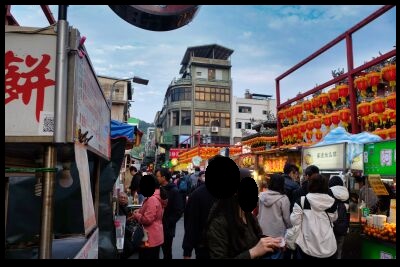

Shilin Night Market is the largest tourist night market in Taipei City, and it is extremely popular with both locals and tourists. The night market operates from evening until late at night, offering a variety of food, shopping, and games.
Shilin Night Market originally started in front of the Cixian Temple. In 1909, the Shilin Market was established, and the night market gradually expanded around the market. In 2002, the new Shilin Market opened, forming the current layout.
Although it is named Shilin Night Market, it is more accessible from Jiantan Station on the MRT Tamsui-Xinyi Line (Red Line) than from Shilin Station. It is about a 5-minute walk from Jiantan Station, making it convenient for tourists to visit.
Shilin Cixian Temple 士林慈誠宮

Shilin Cixian Temple is a historic temple located in the heart of Shilin Night Market, dedicated to the Heavenly Mother (Mazu) as its main deity. It was established in 1796 (the first year of the Jiaqing Emperor’s reign in the Qing Dynasty) and was originally called “Tianhou Temple.”
The history of Shilin Cixian Temple is closely tied to the development of the Shilin area. In 1796, He Jintang donated the land, and the temple was established as Tianhou Temple. In 1895, the temple was destroyed during a conflict between people from Zhangzhou and Quanzhou, but it was later rebuilt under the leadership of Pan Yongqing. After the destruction, both the Shilin area and the temple were rebuilt, resulting in the current Cixian Temple. The temple is a typical example of Minnan-style architecture, with two halls, two corridors, and two protective wings arranged in a planar layout.
Shilin Cixian Temple features traditional Minnan-style architectural characteristics. The roof is designed in the “Xieshan Chongyan” style, with upturned eaves. The single coiled dragon octagonal pillars at the central gate were built during the Guangxu period, and the left and right qilin sculptures date back to 1828. The colorful paintings of palace maids and door gods on the gate are intricately crafted by artisans.
Shilin Cixian Temple is an important place of worship for the local people, hosting various religious events centered around Mazu worship. Mazu is known as the guardian deity of the sea, and many people visit the temple to pray for safe voyages and prosperous businesses.
Grand Hotel 圓山大飯店


The Grand Hotel was established by Soong Mei-ling, the wife of Chiang Kai-shek. It opened in 1952, and the current 14-story Chinese palace-style building was completed in 1973. The hotel is characterized by its red pillars and golden tiles, exuding a luxurious and classical atmosphere. The architecture showcases the beauty of Chinese design, with decorations such as dragons, stone lions, and plum blossoms. The Grand Hotel has 500 guest rooms, each offering beautiful views of Taipei City. The rooms are designed with an oriental classical aesthetic, combined with modern luxury.
The hotel features several restaurants where guests can enjoy Chinese and Western cuisine. The dishes, especially those using imperial culinary techniques, are particularly popular. The hotel also has an underground passage built during Chiang Kai-shek’s era, which is now open to the public by reservation. This passage leads to Jiantan Park and Beian Park, making it a spot of historical interest.
Jiantan Mountain 剣潭山観景台

Jiantan Mountain has an elevation of 206 meters and features a relatively easy hiking trail. The trail is approximately 3.3 kilometers long and takes about 1.5 hours to complete. From the observation deck at the summit, you can enjoy stunning views of Taipei 101, Songshan Airport, the Keelung River, and Dajia Riverside Park.
The hiking trail is surrounded by rich nature, allowing you to enjoy the sights and sounds of squirrels and birds. The forest is covered with trees such as camphor and Machilus. Along the way, you might encounter locals enjoying karaoke, providing a unique cultural experience. The trail also has rest areas and toilets, ensuring a comfortable hiking experience.
National Revolutionary Martyrs’ Shrine 忠烈祠

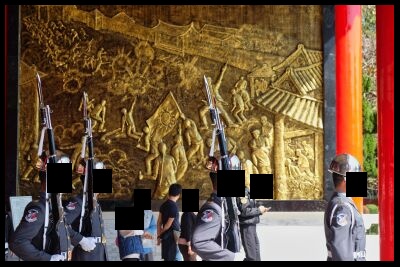
The National Revolutionary Martyrs’ Shrine was built in 1969. It is a place dedicated to honoring the spirits of Chinese revolutionaries and soldiers who lost their lives in events such as the Xinhai Revolution and the Second Sino-Japanese War. The building is designed in the style of the Hall of Supreme Harmony in the Forbidden City (Beijing), featuring a grand and majestic design.
One of the most famous events at the Martyrs’ Shrine is the changing of the guard ceremony. This solemn ritual is performed every hour by selected soldiers from the army, navy, and air force. The main hall, located at the back of the central plaza, enshrines approximately 330,000 martyrs who died for the revolution and the founding of the nation.
Recommended Tourist Spots Around Yuanshan Station
Huabo Park 花博公園

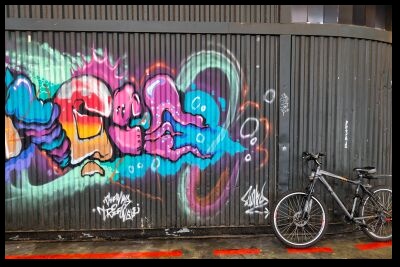
Huabo Park is located in the center of Taipei City and covers an area of approximately 91 hectares. The park features many themed areas where visitors can enjoy seasonal flowers and plants. It was developed as the venue for the 2010 Taipei International Flora Exposition and has since been a beloved park for both residents and tourists.
Linji Huguo Chan Temple 臨濟護國禪寺

Linji Huguo Chan Temple was founded in 1900 and officially opened in 1912. It was established by Umehara Genshu, a monk of the Myoshinji branch of the Rinzai school, during the Japanese colonial period. The temple was named “Chinnan Huguo Linji Temple” by Kodama Gentarō, the then Governor-General of Taiwan.
The Main Hall (Daxiong Baodian), located at the center of the temple, is where major Buddhist ceremonies are held. It features a distinctive double-eaved hip-and-gable roof, creating a solemn atmosphere. The Mountain Gate (Sanmon) at the entrance is a typical example of Edo-period Japanese Buddhist architecture, welcoming visitors. The Bell Tower Gate (Shōrōmon) houses the temple bell, which rings every morning and evening.
Linji Huguo Chan Temple regularly conducts Zen meditation sessions, providing visitors with opportunities for calm reflection and introspection. Throughout the year, various Buddhist ceremonies and festivals are held at the temple, attracting many worshippers, especially during the Lunar New Year and the Ullambana Festival (Obon)
Mt. Lungtung 龍峒山

Mt. Lungtung has an elevation of approximately 36 meters, making it a relatively low hill. The name “Lungtung” originates from the “Dalongbang Society” of the Ketagalan tribe, a subgroup of the Plains Indigenous Peoples who once lived in this area. It was later renamed “Yuanshan.”
Mt. Lungtung is surrounded by lush natural environments, making it ideal for walks and light hikes. From the summit, you can enjoy views of Taipei City. The area around the hill is dotted with historical buildings and temples, offering a cultural exploration experience.
Yuanshan Nature Landscape Park 圓山自然景觀公園

Yuanshan Nature Landscape Park was developed into its current form after the old Yuanshan Children’s Amusement Park closed in 2014. The park features extensive lawn areas and mountain areas, allowing visitors to enjoy both nature and history. The Yuanshan Children’s Amusement Park was a memorable place for many Taipei residents, and its remnants, such as the Ferris wheel and carousel, have been preserved.
The expansive lawn area is perfect for picnics and walks, offering plenty of space for free play, making it popular with families. Although the preserved Ferris wheel and carousel are no longer operational, they are popular photo spots. This location is also frequently used for filming music videos.
Taipei Fine Arts Museum台北市立美術館
Taipei Fine Arts Museum officially opened on December 24, 1983. The museum houses approximately 4,000 modern and contemporary art pieces, with a particular focus on masterpieces of Taiwanese art.
The building was designed by the renowned Taiwanese architect Kao Er-Pan. It features a modern design with bright spaces that make extensive use of glass. Inside the museum, there are 23 exhibition rooms, a café, an art bookshop, a library, an audiovisual room, a nursing room, art classrooms, and parking facilities.
Dalong Street Night Market 大龍街夜市
Dalong Street Night Market is located near the Taipei Confucius Temple and Dalongdong Baoan Temple, offering different attractions in the morning and evening. Although it is not large in scale, it features many traditional old shops, allowing visitors to enjoy the local atmosphere. This area has been a gathering place for people since the Qing Dynasty and has a long history. Dalong Street Night Market is part of this history, providing local culture and food.
Taipei Confucius Temple 孔子廟

Taipei Confucius Temple was established in 1879 but was relocated to its current location in 1939. Initially, it was situated near the South Gate of Taipei City. The temple adopts the architectural style of the Confucius Temple in Qufu, Shandong Province, the hometown of Confucius, characterized by its simplicity and solemnity.
At the center of the Confucius Temple is the Dacheng Hall, where a statue of Confucius is enshrined, and visitors pay their respects. Dacheng Hall is the most important place in the temple, exuding a solemn atmosphere.
None of the pillars, gates, or windows in the Confucius Temple have couplets (paired poetic lines). This is because no one should flaunt their literary skills in front of the sage Confucius. This unique feature is one of the temple’s attractions.
The decorations of the Confucius Temple use techniques such as Koji pottery and cut-and-paste ceramics, which are unique to the Minnan region. These beautiful decorations are unique to Confucius Temples in Taiwan and delight visitors.
Every year on Teachers’ Day (September 28), music and dance performances are held, and offerings such as wine are made to show respect for Confucius. On this day, many visitors from both domestic and international locations come to the temple, making it especially lively.
The Confucius Temple regularly hosts traditional elegant music and dance performances, allowing visitors to experience Confucian culture. These performances, which recreate ancient ceremonial music and dance, captivate visitors with their graceful movements and music.
Dalongdong Baoan Temple 大龍峒保安宮
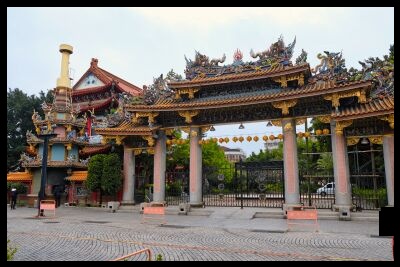
Dalongdong Baoan Temple enshrines Emperor Baosheng, the god of medicine. The temple was founded in 1742. Initially, it was a modest structure, but it was rebuilt in 1830 to its current scale of three halls and three courtyards. During the Japanese colonial period in 1918, significant renovations were carried out. In 1985, it was designated as a national third-class historic site in Taiwan, and in 2018, it was upgraded to a national historic site.
Emperor Baosheng is the main deity of Dalongdong Baoan Temple. He was a real person renowned as a great doctor during the Song Dynasty. He began to be worshipped here during an epidemic.
Emperor Shennong is the god of agriculture, depicted with the head of an ox and the body of a human. He is credited with inventing farming tools and guiding people from hunting to farming.
Zhusheng Niangniang is the goddess of childbirth and treasure. She is said to hold a birth register in her left hand and a brush in her right hand to manage childbirth.
Dalongdong Baoan Temple features traditional wooden structures with a Sanhe Yuan-style roof and wide, flat red bricks and tiles, heavily influenced by Fujian Province’s architectural style. The temple is adorned with vibrant artistic decorations, including wood carvings, stone carvings, colorful paintings, Koji pottery, and cut-and-paste ceramics.
Baosheng Cultural Festival: On the 15th day of the third lunar month, the birthday of Emperor Baosheng, lively parades and traditional ceremonies are held. The “Fire Walking Ceremony,” where participants carry a palanquin and walk over a path of burning coals, is a must-see event.
Juexiu Temple 台北覚修宮
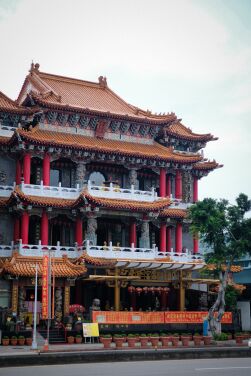
Juexiu Temple is a historic Taoist temple primarily dedicated to Fuyou Dijun (Lü Dongbin). It was founded in 1902 as “Le Shan She” and was relocated to its current location in 1914, where it was renamed “Juexiu Hall.” In 1949, it was rebuilt and renamed “Juexiu Temple,” which it remains today.
Fuyou Dijun (Lü Dongbin) is the main deity of Juexiu Temple and is known as one of the Eight Immortals. Lü Dongbin is a Taoist immortal, particularly revered as a deity of health and longevity. Besides Fuyou Dijun, the temple also enshrines the Five Benevolent Lords: Guan Sheng Dijun (Guan Yu), Yue Wumu Wang (Yue Fei), Long En Zhenjun, and Siming Zhenjun.
Juexiu Temple features traditional Taoist architecture with vibrant decorations. Highlights include intricate wood carvings, stone engravings, colorful paintings, and artistic Koji pottery.
Every year on the 14th day of the 4th lunar month, a grand festival is held to celebrate the birthday of Fuyou Dijun. On this day, many devotees gather to offer their prayers. The temple also practices a form of Taoist divination known as Fuji, where a Taoist priest enters a trance to receive divine messages.
Recommended Tourist Spots Around Minquan West Road Station
Shuangcheng Street Night Market 雙城街夜市
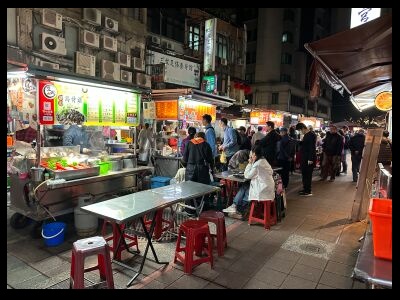
Shuangcheng Street Night Market is not very large, but this means it doesn’t get so crowded that you can’t move, making it easy to enjoy the night market. Despite its small size, the stalls offer a wide variety of food.
Wenchang Temple 文昌宮

Wenchang Temple is a significant place in Taipei City, especially for those wishing to improve their academic knowledge. Wenchang Dijun is a deity who has been worshipped by scholars and officials in ancient China, and even today, many students and examinees visit the temple. Particularly before exams, many students come to pray for success, offering tributes to Wenchang Dijun and purchasing amulets.
Wenchang Dijun is a Taoist deity widely believed to govern academics, literature, and the imperial examinations (keju) in ancient China. There are several theories about the origin of Wenchang Dijun. One theory suggests that Hui, a descendant of the Yellow Emperor, became Wenchang Dijun. Hui was born 97 times from the Zhou to the Yuan dynasties, dedicating himself to those aspiring to learn, and was deified after his death. Another theory posits that the deity is the deified form of the distinguished Tang dynasty writer Zhang Ya.
The architecture of Wenchang Temple preserves the beauty of traditional Chinese architecture. The roof decorations and pillar carvings are extremely intricate, captivating visitors. The dragon and phoenix carvings on the roof are particularly impressive and perfect for photography. Additionally, the interior decorations are meticulously detailed.
Xinzhongshan Linear Park 心中山線形公園

Xinzhongshan Linear Park is a 500-meter-long walkway connecting Zhongshan Station and Shuanglian Station in Taipei City. This park was designed with the aim of urban regeneration and the utilization of public space, created using the space left after the Taiwan Railway Tamsui Line was moved underground in the 1990s.
In the park area near Wenchang Temple, there is a bronze statue of Gao Shi, a hero who sacrificed his life to rescue passengers from a bus stranded on the tracks during an accident.
Recommended Tourist Spots Around Zhongshan Stationu
Zhongshan Station 中山駅付近
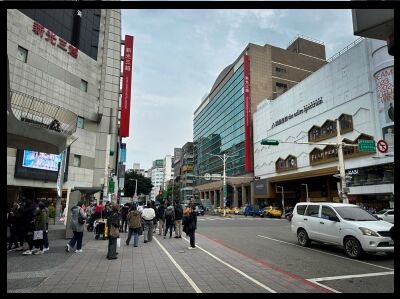
Zhongshan Station is an important station where the Tamsui-Xinyi Line and the Songshan-Xindian Line of the Taipei MRT intersect. This makes it very convenient to access other major areas within Taipei City. It is also just one stop away from Taipei Main Station, making it an ideal location for tourists and business travelers.
Around Zhongshan Station, there are large department stores and shopping malls such as Shin Kong Mitsukoshi and Eslite Bookstore. This allows you to enjoy shopping for fashion, miscellaneous goods, and cosmetics, as well as indulge in gourmet experiences at many restaurants and cafes.
The area around Zhongshan Station also has many tourist attractions, including the Taipei Fine Arts Museum, Xingtian Temple, and Shuanglian Market. These spots are popular with tourists and contribute to the overall vibrancy of the area.
Linsen Park 林森公園
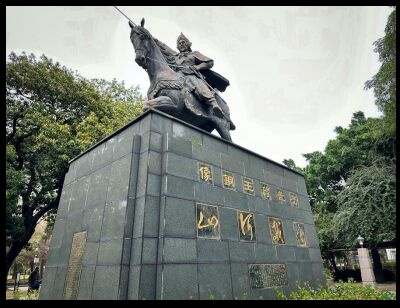
Linsen Park was once used as a communal cemetery during the Japanese colonial period. As a remnant of that time, there are two torii gates in the park. The park’s name is derived from Lin Sen, who served as the Chairman of the National Government.
Statue of Yue Fei: A statue of Yue Fei, a famous hero in the Chinese-speaking world, is installed in the park. This statue is a symbolic presence in the park.
Torii Gates: There are torii gates for Akashi Motojirō and Kamata Masatake in the park, which were erected in 1935. These torii gates indicate the remnants of the former communal cemetery.
Trees in Linsen Park: The park is planted with a variety of trees, including bald cypress, banyan, camphor, redwood, and cherry trees. These trees provide lush greenery to the park.
Location: Linsen Park is located on the east side of Linsen North Road, while Kang Le Park is on the west side. Kang Le Park features a fountain called the Parent-Child Mist Plaza, which is popular with families.
Linsen North Road 林森北路
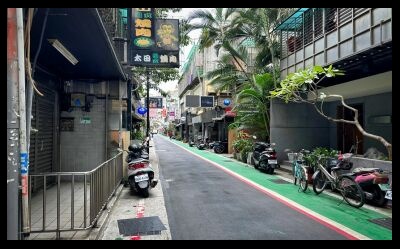
Linsen North Road is a major thoroughfare running north-south through the Zhongshan and Zhongzheng districts of Taipei City, and the entire area is also known as an entertainment district.
Linsen North Road is located in an area that was called “Taisho Town” during the Japanese colonial period and flourished as a Japanese enclave. After the war, this area was renamed “Jiutai Street,” and in 1968, it was renamed “Linsen North Road” after Lin Sen, the Chairman of the National Government.
Linsen North Road is famous for its many restaurants, bars, and clubs where Japanese is spoken. Especially between Chang’an East Road and Nanjing East Road, there are many Japanese-style izakayas and karaoke bars. This area features traditional Japanese-style tiled houses and torii gates, remnants of the Japanese colonial era. Linsen North Road offers a variety of dining options, from authentic Taiwanese cuisine to Japanese and international restaurants. Many staff members speak Japanese, making it a friendly area for Japanese tourists.
Nightlife Hub: At night, Linsen North Road lights up with neon signs and becomes a lively atmosphere. Many bars and clubs are open, bustling with locals and tourists. Despite being an entertainment district, the safety is relatively good, as is typical in Taiwan.
Taipei Museum of Contemporary Art 台北當代藝術館
Taipei Museum of Contemporary Art is a contemporary art museum located in the Datong District of Taipei City. It opened in 2001 and was established as Taiwan’s first museum dedicated to contemporary art.
The building was constructed around 1920 during the Japanese colonial period and was originally used as “Jiancheng Elementary School.” After 1945, it served as the Taipei City Government office, and following the relocation of the city government in 1994, it was repurposed as a museum.
The museum is a two-story brick building with a porch featuring Corinthian columns at the front. Inside, the former classrooms are used as exhibition rooms for contemporary art displays.
Recommended Tourist Spots Around Taipei Main Station
Taipei Main Station
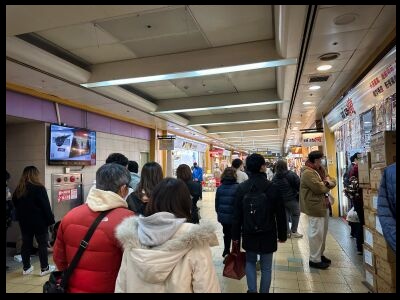
Taipei Main Station is a structure with 6 floors above ground and 2 floors underground, incorporating commercial facilities and offices. On the second floor above ground, there is a food court and shopping area called “Breeze Taipei Station,” which is a convenient spot for travelers.
Taipei Main Station Underground Mall (台北地下街) is the largest underground mall in Taiwan, directly connected to Taipei Main Station. Opened in 2000, it stretches approximately 825 meters in length. The underground mall is divided into four areas, each with distinct characteristics:
Y Area: Extending from Taipei Main Station to Beimen Station, this area is filled with fashion, hobby, and restaurant shops. It is particularly popular for spots where you can enjoy Taiwanese subculture and Indonesian cuisine.
K Area: Located along Zhongxiao West Road, this area has many stores selling fashion, miscellaneous goods, and electronic devices. It is especially popular among young people.
Z Area: Connecting Taipei Main Station and Zhongshan Station, this area is well-equipped with shopping and dining options. It is also a convenient means of transportation for locals and tourists.
R Area: Extending from Taipei Main Station to Shuanglian Station, this area mainly features stores selling daily necessities and household goods.
Yixian Park 逸仙公園

Yixian Park is a small park located to the east of Taipei Main Station, named in honor of Sun Yat-sen (Sun Yixian). This park is also known for preserving part of the high-class Japanese-era inn “Umeyashiki,” where Sun Yat-sen once stayed.
Within the park, there is the “National Father Historical Relic Museum,” which displays furniture and letters used by Sun Yat-sen during his stay. The park is designed in the style of a Jiangnan garden, featuring ponds, artificial hills, and pavilions. At the entrance of the park stands a bronze statue of Sun Yat-sen, welcoming visitors.
The name Yixian Park is derived from Sun Yat-sen’s pseudonym, “Yixian.” When Sun Yat-sen visited Taiwan in 1913, he stayed at “Umeyashiki,” which was built during the Japanese colonial period. This inn is now preserved as the “National Father Historical Relic Museum.
Recommended Tourist Spots Around National Taiwan University Hospital Station
228 Peace Memorial Park 二二八和平公園
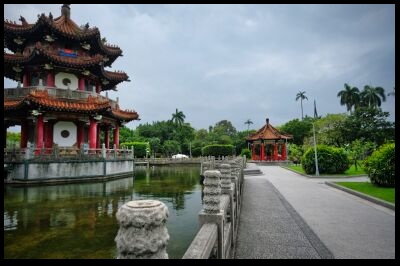
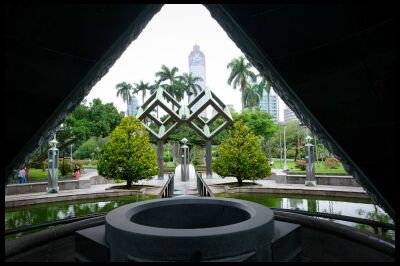
228 Peace Memorial Park was originally opened in 1908 during the Japanese colonial period as “Taipei New Park.” In 1996, it was renamed to commemorate the victims of the 228 Incident, a tragic event that occurred on February 28, 1947, resulting in the deaths of many Taiwanese residents.
Within the park, there is a monument dedicated to the victims of the 228 Incident. This monument serves as an important place to learn about the history of the event and to remember the victims. The former building of the Taiwan Broadcasting Association has been repurposed into a memorial museum, where materials and exhibits related to the 228 Incident are displayed. Japanese audio guides are available, allowing visitors to gain a deeper understanding of the event.
The park also features a Chinese-style pavilion surrounded by a pond with koi fish and turtles, making it a beloved relaxation spot for citizens. Additionally, there is a reflexology path to promote health, providing a fun way for visitors to maintain their well-being.
The 228 Incident refers to a large-scale anti-government uprising that began on February 28, 1947, in Taiwan and subsequently spread across the island. This event is considered a significant moment in Taiwan’s history.
After Japan’s defeat in 1945, Taiwan was returned to the Republic of China. However, the corruption and tyranny of the bureaucrats and soldiers from mainland China who occupied Taiwan led to growing dissatisfaction among the Taiwanese residents. On February 27, 1947, a Taiwanese woman selling cigarettes in Taipei was assaulted by a Monopoly Bureau officer, and her goods were confiscated. This incident sparked a protest by citizens the following day, which escalated into a widespread uprising.
The uprising spread throughout Taiwan, with government facilities and shops owned by mainland Chinese being attacked. In response, the Republic of China government dispatched reinforcements from the mainland to suppress the uprising with force. Many Taiwanese were killed, arrested, and imprisoned during this event. The number of victims is estimated to be between several thousand and tens of thousands, but the exact figure remains unknown. This incident marked the beginning of the White Terror (government repression) in Taiwan and had a profound impact on the island’s subsequent political and social developments.
The 228 Incident has become a symbol of Taiwan’s democratization and independence movements. Memorial services are held annually on February 28, and efforts to uncover the truth and restore the honor of the victims continue. In 1995, the Taiwanese government officially apologized for the incident.
National Taiwan Museum 国立台湾博物館
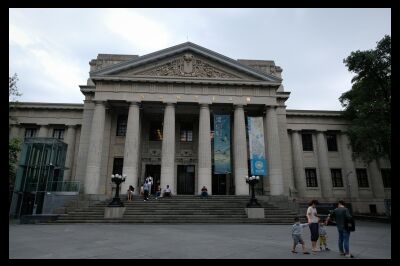
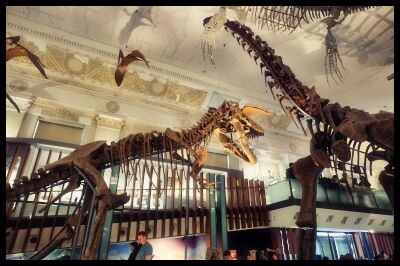
National Taiwan Museum is one of the oldest museums in Taiwan, showcasing the natural history, culture, and history of Taiwan. Here are the details about the museum:
The National Taiwan Museum was established in 1908 and is located in the Zhongzheng District of Taipei City. The museum features a rich collection related to Taiwan’s natural history, culture, and history, playing an important role in education and research.
Paleontology Exhibition: Displays fossils of dinosaurs and ancient organisms, allowing visitors to learn about the evolution of life.
Taiwan’s Natural History: Features extensive exhibits on Taiwan’s endemic flora and fauna, as well as its geology.
Cultural Exhibits: Showcases the culture of Taiwan’s indigenous peoples, historical crafts, and everyday items.
Special Exhibitions: Regularly hosts special exhibitions with changing themes, offering various perspectives on Taiwan’s culture and history.
(Main Building)
(Annex Building)
Taipei Guest House 台北賓館
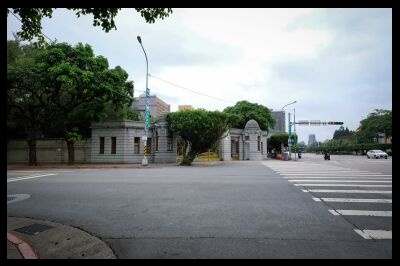
Taipei Guest House is a historic building located in the Zhongzheng District of Taipei City, currently used as the state guest house of the Republic of China. Here are the details about Taipei Guest House:
Construction of Taipei Guest House began in 1899 during the Japanese colonial period and was completed in 1901. The design was handled by Togo Fukuda and Ichiro Nomura, but it was expanded and renovated to its current form in 1911 under the design of Matsunosuke Moriyama. Initially, it served as the official residence of the Governor-General of Taiwan and also functioned as a guest house. After World War II, it was handed over to the Republic of China and has been used as a state guest house since 1950.
The building is a two-story Western-style mansion incorporating French Baroque elements, with a luxurious interior. The front garden is a Western-style garden, while the inner garden is a Japanese-style garden, offering different garden styles to enjoy.
In 1952, the Treaty of Peace between Japan and the Republic of China was signed at Taipei Guest House.
Taipei Guest House is open to the public several times a year. The dates of public openings can be checked on the official website. Exhibits recreating the signing of the Treaty of Peace and historical materials from that time are displayed.
Taipei Prefecture City East Gate (Jingfu Gate) 臺北府城 東門(景福門)
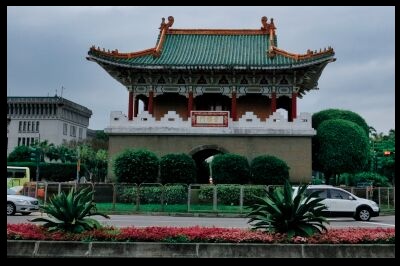
Taipei Prefecture City East Gate (Jingfu Gate) is a historic city gate located in the Zhongzheng District of Taipei City and is one of Taiwan’s important cultural assets. The East Gate was constructed between 1879 and 1884 during the Qing Dynasty. It was established as part of Taipei City to protect the crucial route to Keelung Port.
The East Gate is situated on the eastern side of Taipei City and played a significant role in defending the route to Keelung Port. The gate has a two-story structure, with a passable gate on the lower level. Currently, it is located in the center of a roundabout and is surrounded by a fence. It was renovated by the Kuomintang government in 1966, resulting in significant changes to the original structure. However, in 2009, the Kuomintang emblem that was on top of the gate was removed.
The East Gate, also known as “Jingfu Gate,” holds historical value along with the other gates of Taipei City (North Gate, South Gate, and Little South Gate).
Recommended Tourist Spots Around GuanChiang Kai-Shek Memorial Hall Station
National Chiang Kai-Shek Memorial Hall 国立中正紀念堂
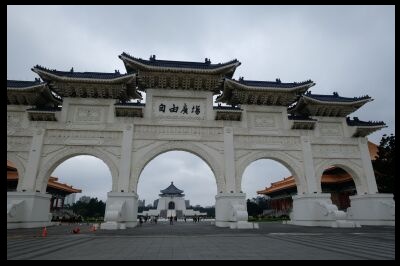
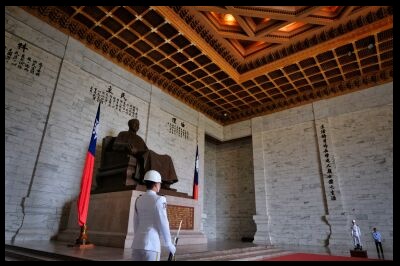
The National Chiang Kai-Shek Memorial Hall is a monument located in Zhongzheng District, Taipei City, dedicated to the first President of Taiwan, Chiang Kai-Shek.
Construction began on October 31, 1976, after Chiang Kai-Shek’s death, and it was opened to the public on April 5, 1980. The design was by Yang Cho-cheng. Built to honor Chiang Kai-Shek’s achievements, it symbolizes Taiwan’s history and culture. The hall adopts the traditional Chinese palace tomb style, featuring an octagonal blue-tiled roof. The roof symbolizes the eight virtues: loyalty, filial piety, benevolence, love, trust, righteousness, harmony, and peace. The building stands 70 meters tall and houses a large bronze statue of Chiang Kai-Shek.
The changing of the guard ceremony, held every hour from 9:00 AM to 5:00 PM, is a popular event for tourists. Elite members of the army, navy, and air force are selected to perform, showcasing their impressive demeanor. Exhibits include Chiang Kai-Shek’s clothing, documents, and photographs, providing insights into his life and achievements. In front of the memorial hall is a vast plaza, often used for events and gatherings. At night, the hall is beautifully illuminated, offering a stunning view.
National Taiwan Museum Nanmen Branch 国立台湾博物館 南門館
The National Taiwan Museum Nanmen Branch is a museum that showcases Taiwan’s historical industrial heritage, particularly focusing on the history of camphor and opium production.
The Nanmen Branch building was constructed in 1899 by the Taiwan Governor-General’s Office and was initially used as a factory for camphor and opium experiments and production. In 1901, it was renamed the Nanmen Factory and functioned as the only public camphor factory in Taiwan during the Japanese colonial period. Camphor production continued after the war, but the factory was privatized in 1967 and subsequently closed.
The building, constructed in 1914, is a two-story structure made of red brick and reinforced concrete. It is now used as a reception and exhibition space. The first floor houses a permanent exhibition room on the history of the Nanmen Factory and the camphor industry, while the second floor is a special exhibition room on Taiwan’s industrial history. Designed by the Governor-General’s Office engineer Ichiro Nomura, the stone building serves as a multipurpose exhibition space. The exterior is grayish-white, characteristic of Meiji-era architecture. A water reservoir built in 1929 for fire prevention at the factory has been restored and is now part of the exhibition space.
228 National Memorial Hall 二二八国家記念館
The 228 National Memorial Hall was established on February 28, 2011, commemorating the date of the 228 Incident. Its purpose is to uncover the truth of the 228 Incident and restore the honor of its victims. It also contributes to the democratization movement in Taiwan and the enhancement of human rights awareness.
Inside the memorial hall, there are ten exhibition areas covering the background, occurrence, progression, suppression, and commemoration of the victims of the incident. Through these exhibits, visitors can learn about the full scope of the 228 Incident. There is a wall inscribed with the names of the victims, allowing visitors to pay their respects. Detailed files on the victims are also displayed, providing visitors with access to comprehensive information about them.
National Museum of History 国立歴史博物館
The National Museum of History was established in 1955. Its purpose is to preserve and exhibit Taiwan’s history, culture, and art. The museum plays an important role in showcasing Taiwan’s rich history and culture, as well as serving as a place for education and research.
The museum building incorporates elements of traditional Chinese architecture and is accompanied by beautiful gardens. Inside the museum, there are exhibits covering Taiwan’s history from prehistoric times to the modern era. The museum features a wealth of artistic works, including ceramics, calligraphy, and crafts. There are extensive exhibits on Taiwan’s indigenous cultures and archaeological discoveries. Important historical artifacts from ancient to modern times are displayed, providing a deep understanding of Taiwan’s history.
Taipei Botanical Garden 台北植物園
The Taipei Botanical Garden was established in 1896 during the Japanese colonial period. Initially known as the “Taipei Nursery,” it served as a facility for researching plants from Taiwan and Southeast Asia. In 1921, it was renamed the “Taipei Botanical Garden,” and today it spans approximately 8.2 hectares, housing over 2,000 plant species.
The garden features a beautiful lotus pond, which is particularly stunning during the summer. Plants related to the Chinese zodiac are planted here, allowing visitors to enjoy flora associated with each zodiac animal. There are also displays of succulents and cacti, showcasing the diversity of plants from arid regions. The garden has a rich collection of ferns, recreating a humid environment.
Plants mentioned in the ancient Chinese poetry collection “Shijing” are also planted here, offering a blend of literature and nature.
A building from the late Qing Dynasty was relocated here in 1933 and is now used as an exhibition facility. The herbarium, built in 1924, displays pressed plant specimens. Visitors can enjoy different plants each season, experiencing the changing landscapes throughout the year.
Nanjichang Night Market 南機場夜市
The name Nanjichang Night Market originates from the Japanese colonial period when the area was called “Nanjichang” (South Airport). It was once used as an airfield, but after the war, public housing was built, and many people began to live there. To support the residents’ daily lives, food stalls increased, eventually developing into the current night market.
Nanjichang Night Market features many stalls that have been selected by the Michelin Bib Gourmand. Popular stalls include “Unnamed Pushcart Shaobing” and “Wu Wang Zai Ji.” You can enjoy traditional Taiwanese dishes such as chicken rice, tube rice pudding, and runbing. Since many locals visit, it offers a more authentic atmosphere compared to night markets aimed at tourists.
Recommended Tourist Spots Around Dongmen Station
Yongkang Street 永康街
Yongkang Street was developed during the Japanese colonial period and has now become a beloved shopping street for both locals and tourists. It is characterized by its historical buildings and traditional atmosphere, making it a delightful area to stroll through.
Din Tai Fung is a world-renowned restaurant famous for its xiaolongbao (soup dumplings) and is a symbolic presence on Yongkang Street. It has also been selected by the Michelin Bib Gourmand.
Dongmen Market 東門市場
Dongmen Market was established in the 1930s and has a history of over 90 years as a traditional market. Features: The market has a covered arcade, allowing you to walk around a U-shaped street. It is lined with shops offering fresh ingredients and traditional Taiwanese cuisine.
Recommended Tourist Spots Around Daan Park Station
Daan Park 大安森林公園
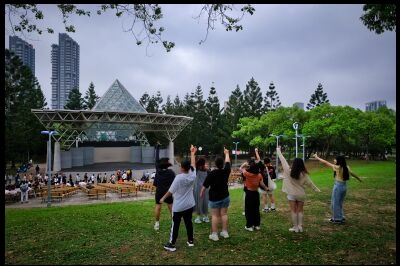
Daan Forest Park is known as the “urban forest,” characterized by its lush greenery and spacious areas. The park is home to many trees and flowers, offering beautiful scenery throughout the seasons.
Leisure Facilities: The park is equipped with various leisure facilities, including jogging paths, cycling roads, playgrounds, and bird-watching areas. It is especially popular with people who enjoy jogging and walking.
Event Spaces: There are music stages and plazas where concerts and events are held on weekends and holidays.
Recommended Tourist Spots Around Daan Station
There weren’t any touristy spots
Recommended Tourist Spots Around Xinyi Anhe StationStation
Tonghua Street Night Market 通化街夜市
Tonghua Street Night Market was officially named “Linjiang Street Tourist Night Market” in 1986, but it is affectionately known as Tonghua Street Night Market by locals. Although relatively small in scale, it is bustling with local people and is also a popular spot for tourists. The night market spreads around the intersection of Tonghua Street and Linjiang Street, with many stalls lining up as night falls. In addition to food stalls, there are many shops selling clothing and miscellaneous goods, making it a great place for both eating and shopping.
Zhenghao Fresh Meat Xiao Long Tang Bao: This stall offers exquisite xiao long bao made with Sanxing green onions, a specialty of Yilan.
Luo Ji Stir-Fry: A stir-fry restaurant selected by the Michelin Guide’s Bib Gourmand, perfect for enjoying even with a small group.
Honghua Honggui Sausage: A sausage stall offering more than 20 different sauces.
Shijia Gua Bao: A long-established gua bao (Taiwanese hamburger) shop founded in 1953, known for its braised pork belly.
Jiaotang Feng Skewers with Chinese Herbal Powder: Popular for its skewers seasoned with a blend of original spices and Chinese herbs.
Recommended Tourist Spots Around Taipei 101 / World Trade Center Station
Taipei 101 台北101
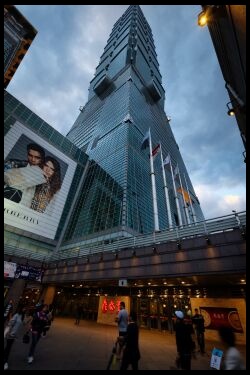
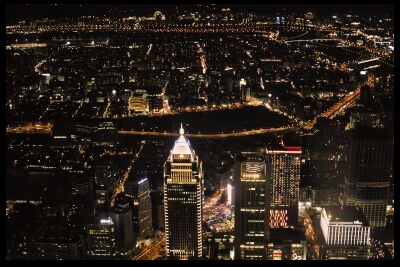
The exterior of Taipei 101 is designed to resemble bamboo, which is considered auspicious in Taiwan. The building has sections every eight floors, with a total of eight sections, symbolizing the lucky number “8” in Chinese culture.
Elevators: The Toshiba-made elevators are recognized by the Guinness Book of World Records as the fastest in the world, reaching the 89th-floor observatory from the ground floor in just 39 seconds.
Tuned Mass Damper: To reduce vibrations caused by wind and earthquakes, a massive 660-ton tuned mass damper is installed. This device can reduce the building’s sway by up to 40%.
From the indoor observatory on the 89th floor, you can enjoy a 360-degree view of Taipei City. On clear days, you can even see the ocean to the northeast.
The outdoor observatory on the 91st floor offers an open-air experience, although it may be closed during bad weather.
The basement to the 5th floor houses a shopping mall with luxury brand stores and restaurants from around the world. It is an excellent place to buy local specialties and souvenirs.
The Taipei 101 Countdown Fireworks

The Taipei 101 Countdown Fireworks is a major event that attracts many tourists and locals every year. Fireworks are launched from the entire Taipei 101 building, with 16,000 fireworks lighting up the night sky over approximately 300 seconds. Along with the fireworks, you can enjoy music and light shows, making it a multi-sensory experience to welcome the New Year.
Viewing Spots:
Xinyi District: Located to the north and east of Taipei 101, Xinyi District is an ideal place to watch the fireworks. The intersections of Songzhi Road and Songren Road are particularly recommended.
Elephant Mountain: From the Elephant Mountain hiking trail, you can enjoy beautiful fireworks with Taipei 101 as the backdrop. However, the trail is expected to be crowded, so it is advisable to arrive early.
Songshan Cultural and Creative Park: This cultural facility, renovated from an old tobacco factory, also offers a good view of the fireworks.
Traffic Restrictions: On the day of the countdown, large-scale traffic restrictions will be implemented around Taipei 101. Restrictions will begin in stages from 7:00 PM, and surrounding roads will be completely closed after 10:00 PM. For public transportation, MRT Taipei 101/World Trade Center Station, Xiangshan Station, and City Hall Station are convenient options.
Additional Information:
Observatory Hours: On December 31, the Taipei 101 observatory is open until 7:00 PM. Due to preparations for the fireworks, the outdoor observatory on the 91st floor will be closed from December 23 to January 1, but the indoor observatories on the 88th and 89th floors will remain open as usual.
Si Si Nan Cun 四四南村
Si Si Nan Cun is a historical settlement located in the heart of Taipei City, which was once home to military personnel and their families. The government prepared this residential area for people who worked at the “44th Arsenal.”
Today, Four Four South Village has been redeveloped into a tourist spot that retains its retro atmosphere while featuring stylish cafes and shops. One of its attractions is its convenient location, just a 5-minute walk from Taipei 101.
Four Four South Village Simple Market (Main Plaza): A market is held on weekends, attracting many tourists.
Taipei Military Dependents Village Museum: This museum offers a glimpse into the lives of the military personnel who once lived here. Admission is free, and exhibits include scenes of daily life and tools used for work at that time.
Recommended Tourist Spots Around Xiangshan Station
Xiangshan hiking trail 象山ハイキングコース
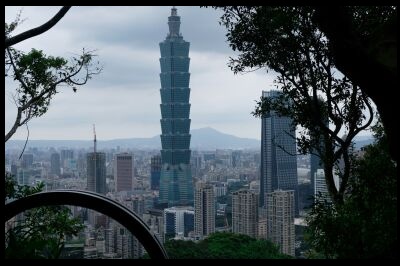
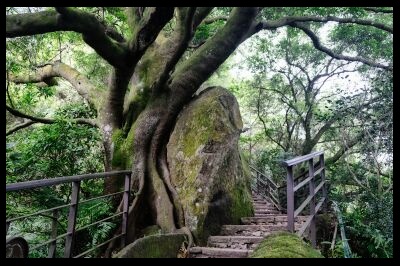
From Xiangshan Station, it takes about 10 minutes on foot to reach the entrance of the hiking trail. The access from the urban area is very convenient. The course itself is relatively short, taking about 20-30 minutes to reach the top. However, there are many stairs and steep slopes, so it is recommended to proceed slowly if you are not confident in your physical strength.
The course has several observation decks, offering spectacular views, especially with Taipei 101 in the background. The night view is also beautiful, making it perfect for photography. Xiangshan is lush with greenery, providing a relaxing escape from the city’s hustle and bustle. You can enjoy the sounds of birds and the wind while hiking.
Xiangshan Beixing Pavilion Trail is a popular route among tourists, with many signs making it easy to navigate. Xiangshan Shiliu Trail is a relatively quieter route favored by locals. It is recommended for those who want to enjoy hiking in a peaceful environment.
Daitian Temple Lingyun Palace 代天殿霊雲宮
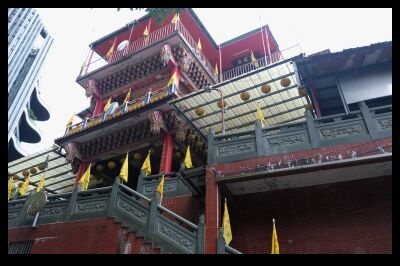
Daitian Temple Lingyun Palace was originally established as “Daitianfu Sheng’en Palace” but was renamed to its current name in 1969. This temple enshrines the main deity, the Three Saints Emperor (Yang Zongbao), who was deified as the son of the famous Northern Song Dynasty general Yang Liulang.
The main deity, the Three Saints Emperor, is known as a brave warrior and is particularly believed by followers to bring good fortune and health. The temple is adorned with beautiful carvings and decorations, captivating visitors. Notably, the shrine of Wangmu Niangniang on the third floor is believed to bring health benefits.
For hikers, there are water dispensers, toilets, and benches available, making it a convenient stop during the Xiangshan hike.



コメント